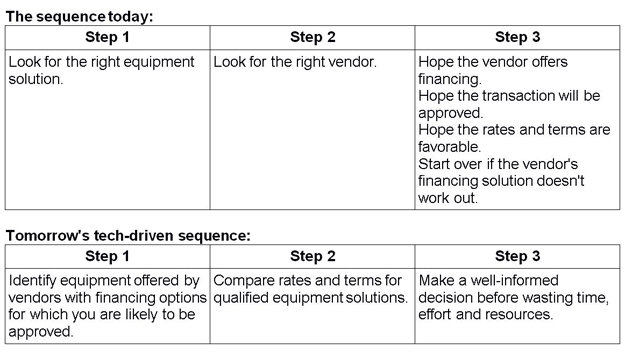
Sometimes when a certain type of business has been conducted in a particular way over a long period of time, it's easy for industry players to get comfortable with the status quo and difficult to imagine there might be a new and better way to get things done. However, with a constant influx of innovative technologies and software solutions changing the way businesses work, it makes sense for company leaders to spend time envisioning how innovation and technology might be used to advance and enhance the companies for which they work, and even the entire industries in which they work.
Our team has spent considerable time contemplating the current equipment leasing and financing industry and wondering how technology could be leveraged to make it better:
- First, we mapped out the status quo – the way things typically work now in equipment financing.
- Then we started asking “what if” questions to see if we could stretch our imaginations beyond the current boundaries and picture a new ideal.
- Finally, using a problem-solution approach, we identified the obstacles between the status quo and our newly imagined industry; and we discussed how we could use technology to create solutions for overcoming those obstacles.
How does equipment financing work today?
While this is an oversimplification of the equipment financing process, and there are also exceptions to the rule, in general, the typical process of financing equipment looks and flows something like this:
- A business has a need and researches an equipment solution that can fulfill that need. This search will consider multiple factors, like: features, functions, capacities, capabilities etc.
- Once the proper equipment is identified, the business researches and compares potential vendors that offer the required equipment. This search will consider factors like: inventory, credibility, reputation, expertise, service and support and location.
- Only after the right equipment and the preferred vendor have been identified, does the purchasing business submit an equipment lease or financing application.
- Now the business people that need the equipment cross their fingers and hope that the equipment vendor's third party leasing or financing partner approves the application.
What's the problem with the status quo?
We considered the current processes and brainstormed some of the shortcomings. Here's what we came up with:
- Uninformed Decisions: Having leasing and financing at the end of the multi-step process, essentially eliminates financing criteria from the procurement decision. I suppose, if a business has very deep pockets, they may not consider the financing terms and overall costs of equipment an important factor; but for most businesses, it should be a very important factor to consider. How do you know if a specific equipment option is the best solution without having the leasing or financing information?
- Limited Options: Most equipment vendors have a relationship with a single third-party leasing or financing company, which limits the end-user to one option. This means there's only one chance to get approved and one set of pricing and terms with zero alternatives. Additionally, even if the equipment vendor had relationships with multiple third-party financing companies, it would be less than ideal to require customers to fill out and submit multiple individual applications and have their credit run over and over again.
- Hasty Decisions: If you spend time, energy and effort sourcing equipment before being approved for financing from a single source, you may be more willing to settle for higher rates and less than favorable terms, just to be done with a cumbersome, time-consuming process and avoid repeating the process with a second or third financing company.
- Wasted Time: If the customer's financing or lease application is denied, or if the rates and terms offered are unacceptable, the time and effort given in steps 1, 2 and 3 become unnecessary waste.
Asking “What If”
One good way to move the mind out of the old and into the realm of new ideas and possibilities is to ignore the current obstacles (we'll figure out how to overcome those later – mostly using technology) and start imagining the ideal by asking “what if” questions:
What if we could use technology to serve up estimated leasing and financing costs and move those details up to the front of the procurement process?
- Then the leasing and financing information would become a primary part of the solution selection criteria – as it should be. This would add a fine layer of solution filtering right at the beginning, and potentially save a lot of wasted time and effort.
What if technology offered a robust pre-approval process based on minimal customer input?
- Customers would know the likelihood of being approved for leases or financing for specific equipment, before going through a rigorous application process.
What if innovative technology enabled us to present the equipment solution, along with a single customer lease/financing application, to numerous leasing companies?
- The customer would only have to fill out one application in order to receive multiple responses. This would increase the likelihood the customer gets approved and enable them to compare various solutions – now with rates and terms included in the decision making process.
What if a technology was developed technology that could analyze a number of factors, such as:
- The specific equipment being sourced
- The customer's qualifications and creditworthiness
- The equipment supplier's qualifications
- Details and data about the leasing or financing companies that may be involved 00and then matching customers with recommended leasing/financing partners based on the data analytics?
- This would improve customer approval rates, decrease lending/leasing default rates and ensure that customers are introduced to those leasing/financing companies which are best suited for this particular type of leasing or financing deal.
Let's sketch out this futuristic equipment financing scenario and see how technology rearranges the process sequence and improves the results for customers, equipment vendors and finance companies.

We hope you agree that the future of equipment financing looks bright – because it's coming…soon. Let us know your thoughts and ideas related to the evolution of equipment leasing and financing.